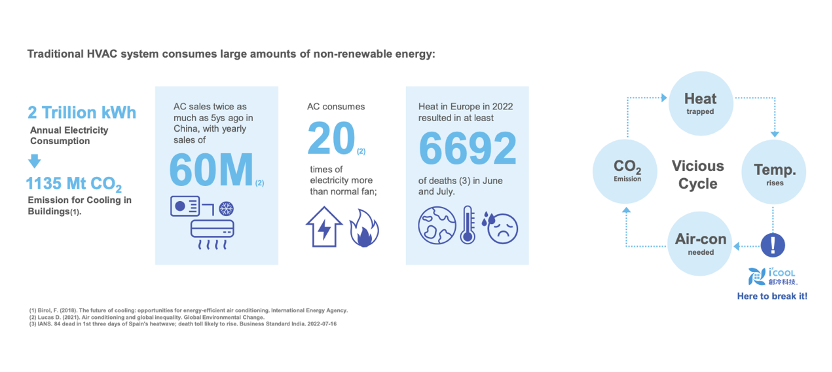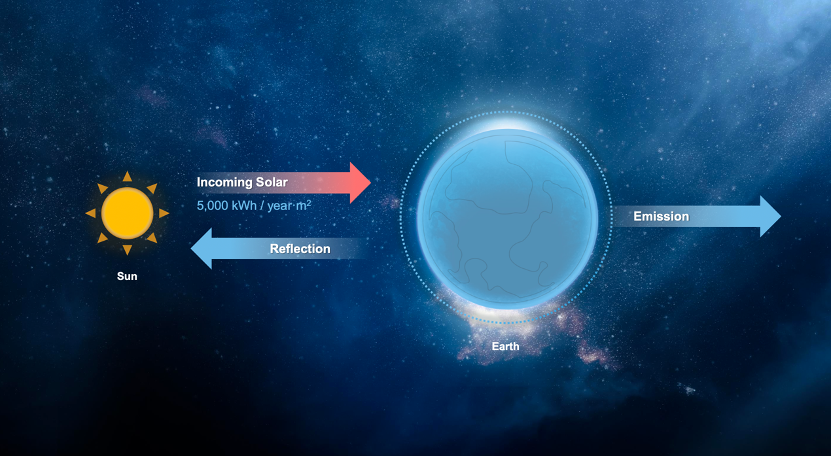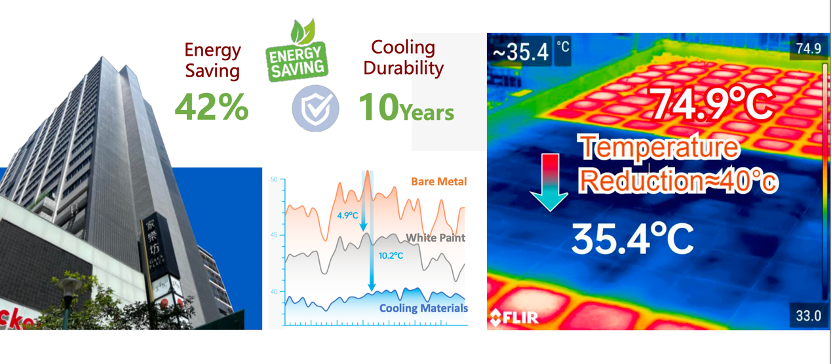It is urgent to address the contradiction between the current dependence on air conditioning systems and the goal of carbon neutrality.
Dependency of Air Conditioning Systems
Currently, there are approximately 60 billion square meters of buildings in China. According to analysis and calculation, the energy consumption during the operation of these buildings leads to the emission of about 2.2 billion tons of CO2. Direct carbon emissions account for about 29%, while indirect carbon emissions from electricity and heat account for about 50% and 21%, respectively. The operation of heating, ventilation, and air conditioning (HVAC) systems in buildings contributes to approximately 990 million tons of CO2 emissions.

Passive Radiative Cooling Technology
To reduce carbon emissions and achieve carbon neutrality, our team have focused our research and development efforts on passive radiative cooling technology. After six years of research and development, we have launched our first commercial product, a passive radiative cooling coating called iPaint.
Passive radiative cooling technology can block the heat from the sun and radiate it into the cold outer space through mid-infrared wavelength radiation, thereby providing a cooling effect to buildings or objects without the need for electricity or refrigerants.
Conventional air conditioning systems consume significant energy, while passive cooling technologies are more energy-efficient and environmentally friendly. Passive radiative cooling technology does not require the consumption of energy or the use of refrigerants in buildings. Moreover, it is a green technology that can alleviate global warming and climate change. Furthermore, the passive radiative cooling technology aligns with the goals set forth in Hong Kong's Climate Action Plan 2050. It can serve as a valuable mechanism for promoting energy conservation within the construction sector.

The passive radiative cooling coating reflects the heat from the sun and enhances the scattering of mid-infrared radiation in the entire solar spectrum. Compared to current commercial coatings, it has thermal solid regulation capabilities and excellent optical properties, achieving a high reflectivity rate (>95%) and mid-infrared radiation capability (>95%). It effectively reduces the surface and internal temperatures of buildings or objects, providing a cooling effect and enormous potential for energy conservation in the construction industry.
International Recognition
Furthermore, we were invited to attend the Innovation Challenge organized by Emaar, Dubai's largest real estate developer. We emerged as the winner among more than 200 outstanding start-ups worldwide, showcasing our innovative and electricity-free cooling technology to promote the carbon neutrality of the Middle East and support global energy-saving technology development. In March of this year, we also won the top prize of 1 million US dollars in the second TERA-Award Smart Energy Innovation Competition jointly organized by TOWNGAS and State Power Investment Corporation, thanks to our electricity-free cooling technology's technical advantages in environmental protection, energy conservation, and efficiency. This is also the highest prize in the history of energy industry technology competitions.

Continuous Innovation
In addition, we will continue to promote our development and the industry's development through scientific research and innovation. Our first-generation product has been extensively verified in the Hong Kong market and expanded to the Greater Bay Area and Asia, continuously exploring overseas markets, Southeast Asia, Middle East, Europe, South America and the United Sates.
The application scenarios of the technology are diverse. They can be applied not only to commercial buildings, construction site offices, and temporary buildings but also to solar panels, outdoor electronic equipment boxes, shipping containers, cars, water tanks, and other chemical raw material storage containers.
In the future, electricity-free cooling products will be derived for a broader range of living scenarios. Combining radiative cooling technology with textiles can produce cooling masks, hats, clothes, umbrellas, and other items, widely promoting energy-saving actions among the public. Through the combination of performance and different materials and industries, we will always place scientific research and innovation at the forefront of our company's mission, aspiring to continuously innovate, explore, and promote the development of environmental protection and new materials industries.